Tuesday 23 February 2010
Tuesday 20 October 2009
8 Shot Journey
Our Task was to produce an 8 shot journey using only camera shots and no camera movement. We were told to show our subject leaving a place and reaching a destination, and it had to be clear and inventive.
I decided that my subject was going to be enter the college, walk across the atrium, enter the media block and go into the TV studio.
To do this, I first started with a wide shot of my subject walking towards the camera and then another shot of the subject walking into the college. I then placed the camera on the turnstiles to give the next shot depth as the subject walked through them and entered the atrium. I then used a mid shot of the subject walking past the tables in the atrium and a close up of her feet which were framed through the legs of a chair. I then used another mid shot of my subject walking into the media block and a close up of her using her card top open the door. Finally I used a mid shot of her walking into the TV studio and then used a fade out at the end. Overall, I was happy with my 8 shot journey however, it was sometimes quite hard to film certain parts due to the fact that the college is very busy during the day and there were lots of people walking into shot whilst we were trying to film.
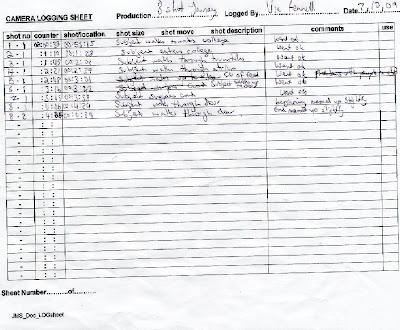
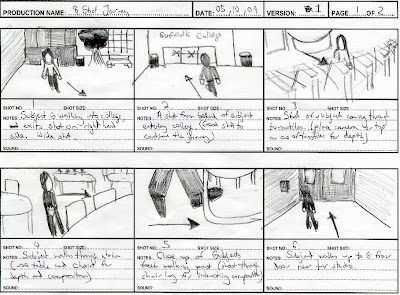
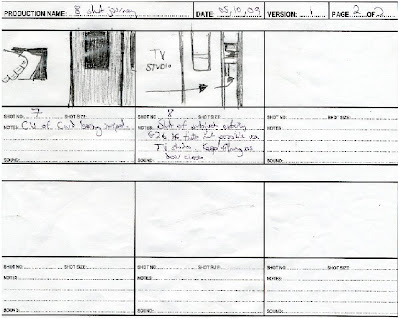
Building Blocks of Cinematography
A frame is a single cell of film. In film-making 24 frames make up one second. So real time film is 24 frames per second (fps). In video, if you wish to shoot real time you will need to shoot 25 fps.
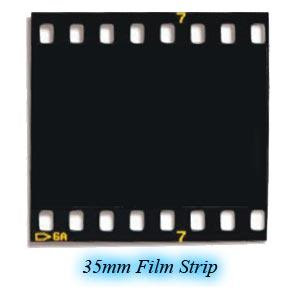 In film and video, a shot is a continuous strip of motion picture film, created by a series of frames that run for an uninterrupted period of time.
In film and video, a shot is a continuous strip of motion picture film, created by a series of frames that run for an uninterrupted period of time.  A sequence is a series of scenes which form a distinct narrative unit, usually connected either by a location, unit, or a passage of time. They can also follow a narrative and usually have a beginning, middle and an end of some description.
A sequence is a series of scenes which form a distinct narrative unit, usually connected either by a location, unit, or a passage of time. They can also follow a narrative and usually have a beginning, middle and an end of some description. A movie (film) or programme, are entire bodies of work. They are created through frames, shots, scenes and sequences. They also have some form of a beginning, middle and end.
Shot Sizes: Communicating Meaning
There are a variety of shot sizes, from extreme close ups (ECU) to a very long shot (VLS)/ wide shot. Different shots serve a different purpose and they communicate information, emotion and details of the intended meaning of the Director.Generally when filming you start away from the action (LS) and gradually move closer (CU) drawing the viewer into the scene and the action.
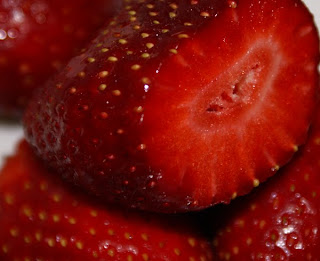
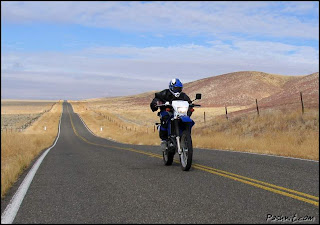

An example of a LS
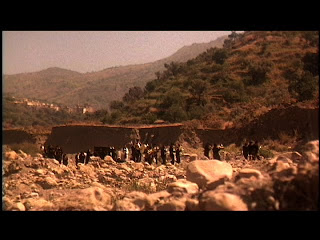
To establish a location or setting it is best to use a wide shot so the viewer can drink in all of the general information. And as there is a lot of it, it needs to be onscreen for a while.
If the Director wants to communicate or highlight something of interest to the viewer, such as an important prop or character emotion, they are likely to use a close up. These need less time onscreen as there is less information to take in.
Composition: Rule of 1/3rds
The rule of thirds is a fundamental rule of composition that objects placed off centre are more interesting to look at.
A grid is imagined over the fame (like noughts & crosses) and generally the eyes are on the top line (eye line), the horizon on the bottom (horizon line) and the subject on either of the two vertical lines.
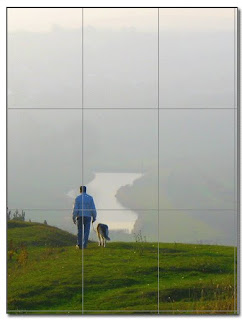
The sweet spots are where the lines intersect and where you want to place the subject, considering looking/moving space.
180º Line Rule: Line of Action
The line of action is and imaginary line you must not cross, or the action will be inconsistent when you cut together during the editing process.
Position 1: Camera below the line, action is moving from right to left in the shot.
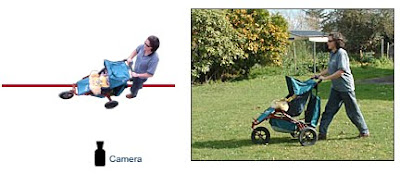
Position 2: Camera above the line, action is moving from left to right in the shot.
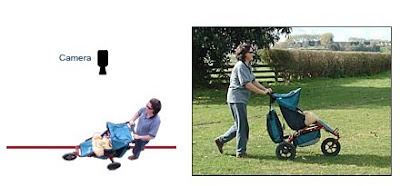 You must always film the action from one side of the 180º line or your action will not edit properly and the movement in the shot will simply not work. The only exception is if you cross the line during a shot by moving the camera across the line during a tracking type shot
You must always film the action from one side of the 180º line or your action will not edit properly and the movement in the shot will simply not work. The only exception is if you cross the line during a shot by moving the camera across the line during a tracking type shot
Camera Angle
High angle shots make the subject of the shot seem weak and inferior.
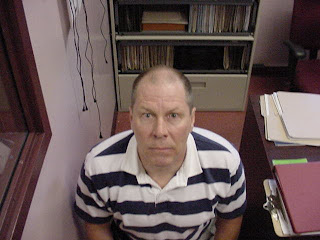
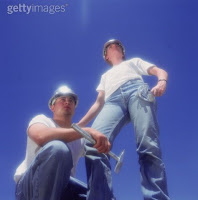 Canted angle or Dutch tilt shots make the frame seem awkward and mysterious as we do not see the world this way.
Canted angle or Dutch tilt shots make the frame seem awkward and mysterious as we do not see the world this way.
Camera Height
As human beings we generally see the world at eye level standing up or sitting down. If we shoot the camera at eye level it is how we are used to seeing the world, so it is comfortable.
Use of Line and Diagonals

Camera Depth of Field and Action Planes
Shallow focus is when certain subjects are in focus and other elements are not and you have a small depth of field. It draws attention to what is in focus.Deep focus is when everything in the shot is in focus and you have a large depth of field. It makes everything in frame seem important as it is all in focus and sharp.Action planes are the foreground, middle ground, and background. The best and most interesting shots incorporate all of these or at least two.
Film/ TV Conventions
Continuity of travel: If your subject enters the shot camera left and exits camera right, this must continue. Only if your subject changes direction in shot and enters camera left and leaves camera left. This works both ways.
Edit points: When shooting, consider your edit points in your head. A good way to go is to let your subject completely leave the frame and then completely enter again in the next shot.
Cut ins and cutaways: These are shots that can help with continuity and also adds to the action. For instance, cutting away from a LS of someone lighting a cigarette to a CU back to the LS. They add interest and can cover up mistakes.
Compression of Time: Film editing is all compression and manipulation of time generally to compress (montage) but can also elongate (slo-mo).
Radio Jingles
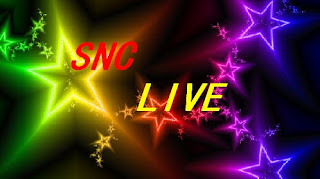
What is a Radio Jingle?
A Jingle is a memorable slogan set to an engaging melody, which is mainly broadcast on Radio’s to advertise shows and the station.
Codes and Conventions of a Radio Jingle
Speech needs to be clear and give correct and relevant information about shows and the station itself.
Sound effect's can be used, but all music must be recognisable and relevant to the target audience for the station. For example, radio one shows are targeted and young adults and teenagers.
The Jingle must identify the station i.e. the frequency (Radio 2 88-91fm) 
Show promo’s must include the presenters name, and idea of what the shows includes (music etc) the time of the show (how long it is) and highlights of previous shows so that listeners can decide whether it is for them.
Script for my show promo
"Long day at the office? *pause* Fed up of school? *pause* wanna get that Friday feeling? Join me Vic Fennell, Fridays at Five; The weekend starts here"
My Radio Jingles
http://www.infinitemb.com/stream/5529/SNC_Live_Station_Ident.mp3/
http://www.infinitemb.com/stream/5530/Vic_Show_Promo_SNC_Live.mp3/
http://www.infinitemb.com/stream/5531/News_Update_mp3.mp3/
Radio Jingles Evaluation
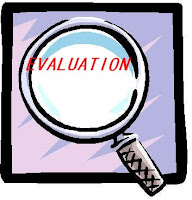 Our Task was to make 3 Radio Jingles, for ‘SNC; Live’. These Jingles were to be for;
Our Task was to make 3 Radio Jingles, for ‘SNC; Live’. These Jingles were to be for;a) A Show Promo
b) The Radio News
c) The Station Ident
We had to make these jingles using Adobe Sound-booth from the I-Macs.
In order to do this task, I had to get some music to be played in my jingles. I brought in some music from my home computer using a USB stick and loaded it on
 to the I-Macs. All of the songs I chose are currently in the UK Top 40 as these are the sort of tracks that can be heard on Radio stations such as Radio 1 and Heart fm. This kind of music was also relevant to my target audience as they would be primarily teenagers who study at the college as well as other listeners who would listen to the show online.
to the I-Macs. All of the songs I chose are currently in the UK Top 40 as these are the sort of tracks that can be heard on Radio stations such as Radio 1 and Heart fm. This kind of music was also relevant to my target audience as they would be primarily teenagers who study at the college as well as other listeners who would listen to the show online.The first jingle I decided to produce was the show promo as this would take the most time and would be the longest jingle. The first thing I did was upload my music into Sound-booth and edit all the tracks so that I had short clips of each of the tracks. I then put them into an order so that they were continuous and didn’t sound jumpy as one track went into another. I then recorded the script I wanted to play over the top and put in the places that I thought made it sound most effective.
Listening back to the Jingle in class, made me realise that I needed to maybe tune down the voice I recorded a touch as it seemed quite loud to me in places. If I was to do this again I would concentrate on balancing out the two audios more effectively.
The second jingle I produced was the Radio News as this was going to be very short. I firstly went onto Beemp3.com which is a mp3 sharing site on the internet. I found a simple “News Jingle” which I downloaded and edited and then placed my scripted audio at the beginning. If I was to do this radio jingle again I would make the bits that were spoken more clearly as they were a bit muffled in places.
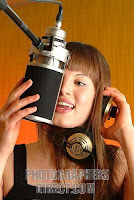
The third and Final Jingle I did was the station Ident. My Ident was largely influenced by stations such as heart fm who use a variety of songs and then a tag line as their station Ident’s. To do this I used a variety of music which is in the charts and edited them to make them shorter. I then recorded my tag line “SNC Live; Playing the Best Music, Everyday” and placed it at the end of my jingle.
When I played this jingle back in class I realised that it was too long and if I was to do it again I would make the song clips shorter so that the Ident would last for 30-40 seconds instead of a minute.
Photography
Photography is the process, activity and art of creating still or moving pictures by recording radiation on a sensitive medium, such as a photographic film, or an electronic sensor. Light patterns reflected or emitted from objects activate a sensitive chemical or electronic sensor during a timed exposure, usually through a photographic lens in a device known as a camera that also stores the resulting information chemically or electronically. Photography has many uses for business, science, art and pleasure.
Genres of Photography
Here are some genres of photography:-
Aerial
Black and White
Commercial
Documentary
Fine Art
Forensic
Glamour
High Speed
Illustrations
Landscapes
Nature
Paparazzi
Photojournalism
Portrait
Still Life
Stock
Underwater
Wedding
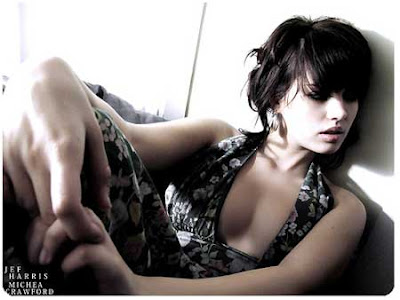
This is a good example of Fashion Photography as the model looks very glamorous and is wearing a designer dress.

This is a good example of Landscape photography as the wooden platform draws your eye into the picture and you can see the horizon in the background.
Camera
A camera is a device that records images, either as a still photograph or as moving images known as videos or movies. The term comes from the camera obscura (Latin for "dark chamber"), an early mechanism of projecting images where an entire room functioned as a real-time imaging system; the modern camera evolved from the camera obscura.
Shutter
In photography, a shutter is a device that allows light to pass for a determined period of time for the purpose of exposing photographic film or a light-sensitive electronic sensor to capture a permanent image of a scene.
Aperture
In optics, an aperture is a hole or an opening through which light travels. In photography, this can be measured in increments called f-stops.
Lens
The lens of a camera captures light from the subject and brings it to a focus on the film or detector.
Exposure Control
The size of the aperture and the brightness of the scene controls the amount of light that enters the camera during a period of time and the shutter controls the length of the time that the light hits the recording surface. Equivalent exposures can be made with a larger aperture and a faster shutter speed or a corresponding smaller aperture and with the shutter speed slowed down.
Health and Safety
Studio
· Cables- as the studio may be dark, care needs to be taken as you may trip over a cable.
· Lights – the flashes get very hot and very bright. Care not to stare into them.
· Backdrops – Very heavy and expensive.
· Coats/Bags – Put somewhere safe to prevent people from tripping over them.
· Food and Drink – No food and Drink anywhere to prevent spillages.
Sensible Behaviour at all times
Dark Room
· Coats/Bags – Put somewhere safe to prevent people from tripping over them.
· Food and Drink – No food and Drink anywhere to prevent spillages.
· Wet and Dry areas – Please keep separate at all times
· Chemical Spills – Please let tutor know immediately if you spill any chemicals.
· Clothing – wear old clothes as chemicals can stain clothes.
What is a Pin-hole camera?
A pinhole camera is a light-proof box with a small hole in one side it is a very simple camera with no lens and a single very small aperture. Light from a scene passes through this single point and projects an inverted image on the opposite side of the box. Cameras using small apertures and the human eye in bright light both act like a pinhole camera .The smaller the hole, the sharper the image, but the dimmer the projected image. Optimally, the size of the aperture should be 1/100 or less of the distance between it and the screen. A pinhole camera's shutter is usually manually operated because of the lengthy exposure times, and consists of a flap of some light-proof material to cover and uncover the pinhole. Typical exposures range from 5 seconds to hours and sometimes days.
Examples of Pinhole Photography
Below is an example of Pinhole photography which was taken by Marcia. C. Sheer in 1984

Here is another example of Pinhole photography byPeter Zirnis which was taken in 1998.
